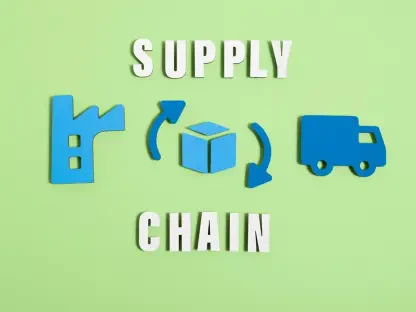Revamping business models to stay competitive has become imperative in today’s rapidly evolving technological landscape. This transformation is evident in the approach taken by HOYER, a respected name in liquid bulk logistics. Established in 1946, this family-owned business has built its reputation on superior service across chemical, foodstuffs, gas, and mineral oil sectors. However, recognizing the need to modernize its operations, HOYER sought a more customer-centric business model, turning to digital innovation as the key to maintaining its industry leadership.
By collaborating with Capgemini, HOYER embarked on a journey to integrate cutting-edge digital solutions. This effort materialized in the development of a user-friendly, serverless, and cloud-native customer portal on Microsoft Azure. As a Minimum Marketable Product (MMP), this initiative demonstrated the effectiveness of leveraging hyperscaler for subsequent applications. The transformation aimed to increase agility, scalability, and efficiency, ultimately enhancing customer engagement and satisfaction.
Enhancing Customer Engagement
The Strategic Partnership: HOYER and Capgemini
The partnership between HOYER and Capgemini represented a strategic alignment of goals focused on enhancing customer engagement through innovative technologies. By utilizing Capgemini’s expertise in digital solutions, HOYER was able to construct a cloud-native platform that prioritizes user experience (UX) and user interface (UI) design. The collaboration began with remote design sprints and an extensive discovery phase intended to streamline the customer journey.
Collecting comprehensive feedback during development was crucial to ensuring the portal met the diverse needs of HOYER’s clientele. The strategic utilization of agile methodologies allowed the project to remain flexible, addressing issues as they arose and pivoting as needed to align with market requirements. This adaptability was fundamental in creating a platform that not only served immediate purposes but could also evolve with future technological advancements and customer expectations.
Benefits of a Cloud-Based Approach
Transitioning to a cloud-based service offered HOYER significant advantages essential for modern logistics operations. The adoption of a serverless architecture underpinned by Microsoft Azure provided scalability, allowing HOYER to handle varying levels of demand seamlessly. This setup also enhanced operational efficiency by automating processes and reducing the need for physical infrastructure, which in turn lowered overhead costs.
Additionally, the cloud-based approach improved data accessibility and security. HOYER could now offer customers real-time updates and quicker response times, improving overall customer satisfaction. The increased security measures inherent in cloud services further ensured that sensitive information remained protected, thereby fostering trust and reliability with clients. The move to the cloud was not just about technological upgrades; it was a holistic enhancement of service quality that had tangible benefits for all stakeholders involved.
Commitment to Innovation
Agile Methodologies and Modern Collaboration
Staying at the forefront of logistics innovation requires an ongoing commitment to modern methodologies. HOYER’s adoption of agile principles underscored its dedication to responsiveness and iterative improvement. Agile methodologies focus on a build-measure-learn framework, which prioritizes continuous feedback and development over traditional ideate-create-validate workflows. This approach accelerates the time-to-market for new features and improvements, ensuring the platform remains relevant and valuable.
Embracing agile also meant fostering a culture of collaboration. HOYER and Capgemini worked closely to ensure a cohesive development process, involving cross-functional teams and regular communication. This collaborative environment was instrumental in overcoming challenges swiftly and effectively, ensuring that the final product was robust, integrated, and maintainable. As technological landscapes evolve, the agile approach provided the flexibility necessary to adapt to new requirements and innovations.
Future Ambitions in Smart Logistics
Charlotte Fischer, Senior Manager of Digital Solutions at HOYER, highlighted the platform’s ability to expand and adapt to future ambitions within smart logistics. By integrating advanced features such as predictive analytics, Internet of Things (IoT) connectivity, and artificial intelligence (AI), HOYER is positioned to lead the next wave of digital transformation in the logistics industry. These technologies offer proactive management of logistics operations, reducing downtime, and optimizing resource utilization.
The collaboration’s success has not only provided immediate value but has also laid the foundation for continuous innovation. This commitment to advancing smart logistics suggests that HOYER is preparing for long-term growth and sustained industry leadership. By remaining agile and responsive to technological trends, HOYER is setting new benchmarks in customer experience and operational efficiency. The focus on innovation ensures that the company stays ahead in a highly competitive marketplace.
A Sustainable Transformation
Continuous Improvement and Customer-Centric Focus
The emphasis on customer-centric digital transformation has underscored HOYER’s commitment to sustainable improvement. Moving beyond traditional logistics models, the company has integrated digital solutions that are not only innovative but also environmentally conscious. By optimizing routes and leveraging predictive analytics, HOYER aims to reduce its carbon footprint, contributing to broader sustainability goals.
This shift towards a more sustainable operation resonates well with customers who prioritize environmental responsibility. By showcasing a commitment to reducing environmental impact, HOYER strengthens its market positioning and brand loyalty. Additionally, the continuous improvement ethos means that the company is always seeking ways to enhance its services, ensuring that customers receive the highest standards of performance and reliability.
Looking Ahead
HOYER’s proactive stance on integrating modern digital solutions places the company in a favorable position as the logistics industry continues to evolve. The collaboration with Capgemini has not only facilitated the development of a robust digital platform but also ensured that HOYER remains responsive to industry shifts. By investing in agility, customer-centricity, and sustainability, HOYER is well-prepared to navigate future challenges and capitalize on new opportunities.
Going forward, the focus remains on refining these technologies and exploring new avenues for expansion. Incorporating emerging trends and maintaining a customer-first approach will be vital to sustaining growth and leadership within the logistics sector. The strategic vision implemented today will shape the trajectory of HOYER’s innovation and success for years to come.
The Path Forward
Modernizing business models to remain competitive has become crucial in today’s rapidly changing technological environment. This shift is exemplified by HOYER, a reputable company in liquid bulk logistics. Founded in 1946, this family-run business has earned a strong reputation through top-notch service in the chemical, foodstuff, gas, and mineral oil industries. Nevertheless, realizing the need for modernization, HOYER aimed for a more customer-focused business model and identified digital innovation as essential for maintaining its market leadership.
By partnering with Capgemini, HOYER initiated a transformation to integrate advanced digital solutions. This collaboration led to the creation of a user-friendly, serverless, and cloud-native customer portal on Microsoft Azure. Developed as a Minimum Marketable Product (MMP), this initiative showed the benefits of using a hyperscaler for future applications. The transformation was designed to boost agility, scalability, and efficiency, thereby significantly improving customer engagement and satisfaction.









